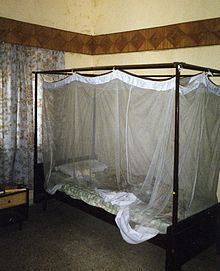




A mosquito net is a type of meshed curtain that is circumferentially draped over a bed or a sleeping area to offer the sleeper barrier protection against bites and stings from mosquitos,[1] flies, and other pest insects, and thus against the diseases they may carry. Examples of such preventable insect-borne diseases include malaria, dengue fever, yellow fever, zika virus, Chagas disease, and various forms of encephalitis, including the West Nile virus.[2]
To be effective, the mesh of a mosquito net must be fine enough to exclude such insects without obscuring visibility or ventilation to unacceptable levels. The netting should be made of stiff cotton or synthetic thread to allow the movement of air. A white net allows the user to see mosquitoes against the background. Netting with 285 holes per square inch is ideal because it is very breathable but will prevent even the smallest mosquito from entering.[3] It is possible to increase the effectiveness of a mosquito net greatly by treating it with an appropriate insecticide or insect repellent. Research has shown mosquito nets to be an extremely effective method of malaria prevention, averting approximately 663 million cases of malaria over the period 2000–2015.[4]
- ^ Oxford English Dictionary (draft ed.). Oxford University Press. 2009.
- ^ "All Mosquito Netting Info". Archived from the original on 2010-03-04. Retrieved 2009-10-27.
- ^ "How to choose a good mosquito net".
- ^ Bhatt, S.; Weiss, D. J.; Cameron, E.; Bisanzio, D.; Mappin, B.; Dalrymple, U.; Battle, K. E.; Moyes, C. L.; Henry, A. (2015-10-08). "The effect of malaria control on Plasmodium falciparum in Africa between 2000 and 2015". Nature. 526 (7572): 207–211. Bibcode:2015Natur.526..207B. doi:10.1038/nature15535. ISSN 0028-0836. PMC 4820050. PMID 26375008.